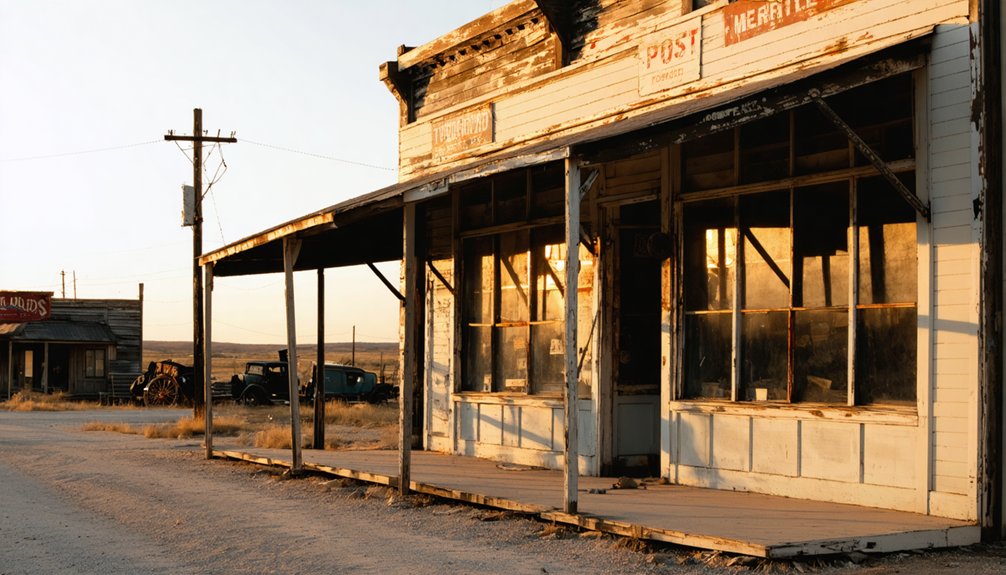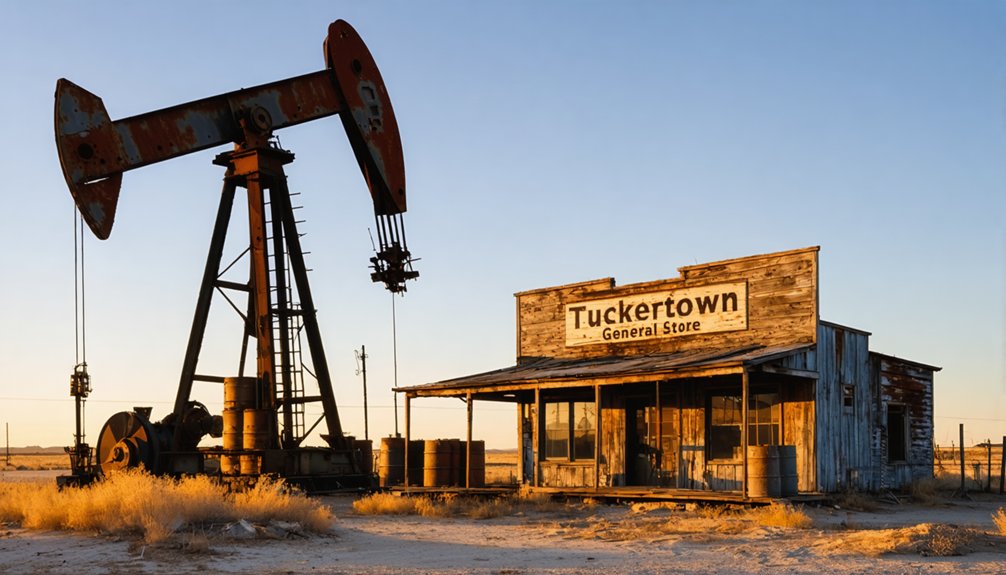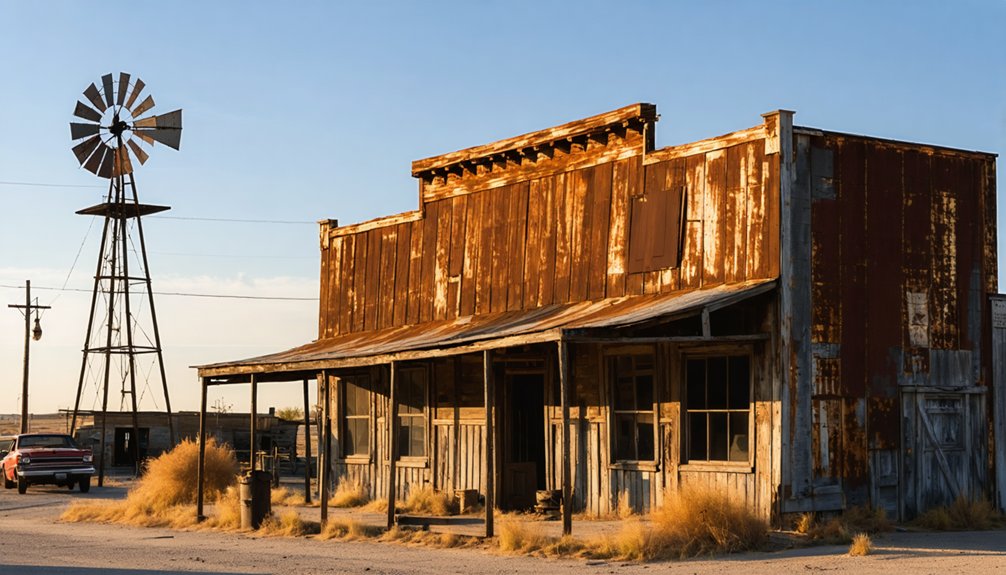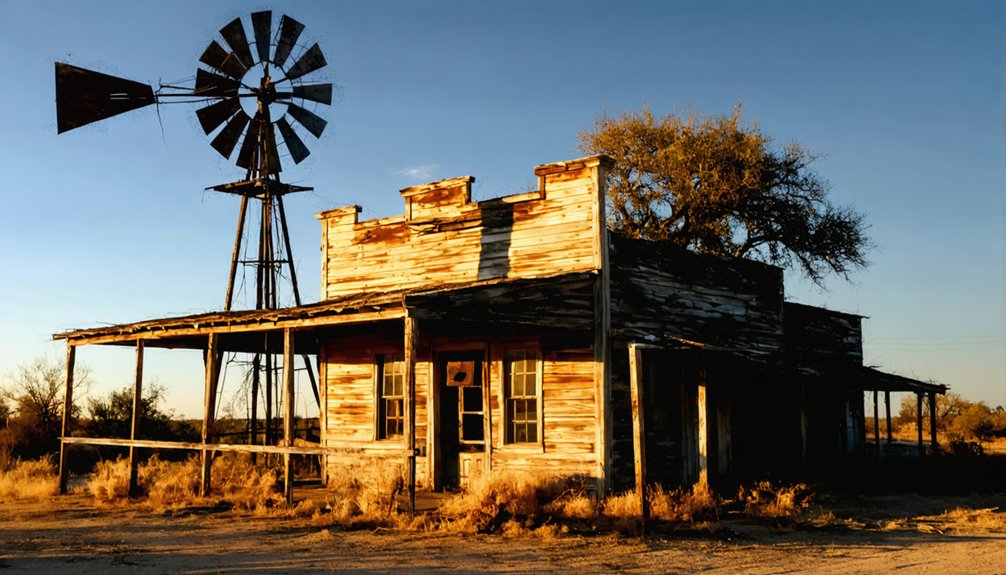You’ll find Tuckertown six miles southeast of Corsicana, Texas, where oil field developer Harry L. Tucker established the boomtown in July 1923. Within three months, the population exploded to 6,000 residents, with Main Street stretching half a mile of wooden storefronts, hotels, and entertainment venues. By 1940, only 20 residents remained as oil operations shifted southwest. The ghost town’s remnants tell a compelling story of Texas’ dramatic oil boom era.
Key Takeaways
- Tuckertown was founded in 1923 by Harry L. Tucker near Corsicana’s oil field, quickly growing to 6,000 residents within three months.
- The boomtown featured a half-mile Main Street with wooden structures, hotels, grocery stores, and entertainment venues serving oil workers.
- Daily life centered around oil operations, with residents living in makeshift housing and using company scrip for purchases.
- The town experienced rapid decline as oil operations moved southwest, leaving only 20 residents by 1940.
- Tuckertown officially became a ghost town by the mid-1960s, with most structures deteriorated and the area largely abandoned.
The Birth of a Boomtown
In July 1923, experienced oil field developer Harry L. Tucker staked his founding vision on McKie’s former ranch land, six miles southeast of Corsicana.
You’d have witnessed the birth of one of Texas’ most dynamic oil boomtowns, strategically positioned near the southern end of the rich Corsicana oil field.
Within just two months, you’d have seen Tuckertown’s population explode to 3,000 souls, then double again in the third month.
Tuckertown’s explosive growth saw 3,000 newcomers arrive in two months, then doubled to 6,000 just thirty days later.
A bustling community identity emerged as wooden buildings with sheet iron and tar paper roofs sprouted along both sides of a dirt road.
The Trinity-Brazos Valley Railroad ran parallel to the gravel road that would become U.S. Highway 287, providing crucial transportation access to the area.
Workers, speculators, and entrepreneurs flocked to the site, quickly establishing grocery stores, cafes, drugstores, a hotel, and various shops to serve the burgeoning population’s needs in this professionally planned oil field settlement.
The Powell field’s incredible output of 32 million barrels in 1923 fueled the town’s explosive growth and attracted thousands seeking their fortunes in the oil industry.
Life During the Oil Rush
While the promise of oil wealth drew thousands to Tuckertown in 1923, daily life proved harsh and dangerous for the workers who braved its chaotic environment.
You’d find yourself living in makeshift tents or crude wooden structures, surrounded by the constant roar of drilling equipment and shouting roughnecks.
Worker struggles were evident in every aspect of life – from the grueling shifts at dangerous well sites to the lack of basic amenities.
Similar to Corsicana’s oil rush, the community relied on hydraulic rotary rigs for drilling operations.
The community’s resilience was tested daily, with a devastating blowout claiming 13 lives in a single incident.
Even getting groceries meant walking to a converted house that served as the town’s only store.
Life revolved around five grocery stores and other essential businesses that sprung up to serve the booming population.
You’d witness a roughneck culture defined by risk-taking and transience, where the promise of prosperity came at a steep price.
A Bustling Main Street
If you’d walked down Tuckertown’s half-mile Main Street in 1923, you’d have passed dozens of storefronts housing everything from grocery stores and hotels to blacksmith shops and drugstores.
The street’s wooden and sheet metal buildings hosted essential services like barber shops and cafes, while a movie house and dancehall provided entertainment for the town’s 6,000 residents. Since Tuckertown is one of several locations sharing this name, it requires careful disambiguation to distinguish it from other similarly named places. Workers were forced to make purchases using company scrip at the stores, limiting their economic freedom.
Despite the muddy or dusty conditions of the unpaved road, Main Street served as Tuckertown’s vibrant social hub where oil workers and locals gathered at cafes, shooting galleries, and various shops that sustained daily life in the booming community.
Storefronts Line Main Road
The bustling main road of Tuckertown stretched for half a mile, lined with a dense array of commercial structures that served its peak population of 6,000 residents.
The storefront design reflected the town’s rapid growth, with buildings crafted from wood, sheet metal, and even canvas. Commercial architecture prioritized function over form, creating a practical marketplace where you’d find everything needed for frontier life. Like The Grove’s two-story brick building, built in 1917, these structures stood as testaments to the town’s commercial aspirations. Today, the main street features mostly brush and abandoned buildings, a stark contrast to its vibrant past.
- Five grocery stores kept residents well-supplied with essential provisions
- Two major hotels offered 55 combined rooms for traveling workers
- Entertainment venues like the movie house and dancehall provided escape
- Machine shops and blacksmiths kept the oil industry running
Between buildings, narrow alleys led to a maze of temporary housing – tents and shacks where workers made their homes during the boom years.
Daily Life and Commerce
Along Tuckertown’s bustling main street, three distinct commercial zones emerged to serve the daily needs of 6,000 residents. You’d find industrial shops clustered together, where the sounds of bit repair, metalworking, and blacksmith hammers filled the air.
Daily routines centered around five grocery stores and clothing shops, where you could purchase necessities before heading to work in the oil fields.
Community interactions flourished in the entertainment district, where you’d spot workers fresh from the showers heading to dance halls and the movie house.
Two large hotels and three smaller ones provided beds for transient workers, while cafes served quick meals.
Behind the wooden and sheet metal storefronts, you’d navigate alleys dotted with outdoor toilets – a reminder of the town’s hasty construction to serve its booming population.
Social Gathering Spots
Walking down Tuckertown’s half-mile stretch of main street, you’d encounter a vibrant mix of social spaces where oil workers and residents alike found entertainment and community.
The bustling thoroughfare offered diverse gathering spots that brought people together after long days in the oil fields. During its peak, these venues served a staggering population of 6,000 residents seeking recreation and connection.
- You could catch the latest films at the movie house, where the flicker of motion pictures transported you beyond the dusty Texas landscape.
- The dancehall gatherings pulsed with music and laughter, offering a chance to forget the day’s toil.
- Local barbershops buzzed with conversation and news, serving as informal town halls.
- Cafes and sandwich shops welcomed both regulars and newcomers, their doors open to anyone seeking a friendly face or hot meal.
The social fabric of Tuckertown wove itself together in these community entertainment spaces, creating bonds that transcended the town’s temporary nature.
Business and Commerce

You’d find Tuckertown’s rapid business growth mirrored the explosive development of the Powell oil field, which ultimately produced 186 million barrels of oil.
The town’s commercial district quickly expanded to include five grocery stores, five hotels, and numerous specialty shops serving both residents and oil field workers.
Local businesses catered specifically to the oil industry’s needs, with establishments like bit and rig repair shops, boiler works, and machine shops supporting the daily operations of drilling crews. Everything began with Percy Fullwood’s store, which served as the original business anchor for what would become the bustling boomtown.
Rapid Commercial Growth
While many boomtowns experienced gradual commercial development, Tuckertown’s business district exploded into existence within mere months of its 1923 founding.
You’d have found remarkable commercial diversity along the half-mile main road, where entrepreneurs seized opportunities to serve the bustling transient workforce of 6,000 residents.
- Five hotels sprang up to house the constant flow of workers and visitors, with the largest offering 40 rooms
- Multiple grocery stores, clothing shops, and drugstores lined the streets, transforming dirt paths into a thriving marketplace
- Essential services like blacksmiths, machine shops, and bit repair facilities kept the oil industry running
- Entertainment venues including a movie house, dancehall, and shooting gallery provided much-needed leisure after long workdays
The mix of temporary and permanent structures reflected the town’s rapid, adaptable growth to meet surging demand.
Oil Industry Support Services
Tuckertown’s lifeblood flowed through its extensive network of oil industry support services, transforming the settlement into a bustling hub of specialized commerce.
You’d find everything from boiler works to machine shops strategically positioned around the Powell Field, creating a robust service diversification that met the demanding needs of oil production.
The workforce dynamics shaped the town’s business landscape, with skilled mechanics, toolmakers, and parts suppliers working alongside fuel providers and equipment specialists.
You could get your drilling equipment repaired, stock up on supplies, or service your vehicles at multiple garages and filling stations.
The town’s business infrastructure wasn’t just about oil – it supported the entire ecosystem of workers, from maintaining machinery to providing essential daily services that kept the boomtown running.
The Peak Years
During its remarkable peak in late 1923, the bustling oil town of Tuckertown swelled to 6,000 residents within just six months of its founding by Harry L. Tucker.
You’d have found a thriving community with extensive infrastructure development and diverse cultural influences, where entrepreneurial spirit flourished in wooden and sheet metal structures along bustling streets.
- You could catch the latest films at the movie house or kick up your heels at the local dancehall.
- You’d find everything from boot repairs to blacksmith services among the town’s dozens of businesses.
- You’d see oil workers gathering at five different grocery stores and lodging at one of five hotels.
- You might grab a meal at one of several cafes while deals were being made all around you.
The town’s rapid growth created a vibrant atmosphere where freedom-seeking individuals could forge their own paths in the Texas oil boom.
Oil Industry’s Impact

Oil production from the Powell Field transformed Tuckertown into a powerhouse of Texas petroleum, yielding an astonishing 186 million barrels that helped establish the state’s dominance in U.S. oil production.
The Powell Field’s massive 186-million-barrel output catapulted Texas into petroleum dominance, transforming Tuckertown from farmland into an oil empire.
You’d have witnessed an unprecedented economic transformation as farmland rapidly gave way to a bustling boomtown of 6,000 residents, complete with machine shops, drugstores, and entertainment venues.
The environmental impact of early extraction methods proved concerning, with wasteful practices threatening the field’s sustainability.
You’ll find it interesting that Tuckertown’s challenges led directly to new state regulations governing oil production.
While the town’s physical presence has vanished beneath pastureland today, its legacy lives on through the regulatory framework it inspired and its role in shaping Texas’s oil industry.
The Gradual Exodus
Despite reaching a staggering population of 6,000 residents within six months of its 1923 founding, Tuckertown’s descent into abandonment began almost as quickly as its meteoric rise.
The population movement followed a pattern you’d recognize in many Texas boom towns, driven by economic factors that left no choice for survival.
By 1940, you’d have found only about 20 hardy souls remaining in Tuckertown. The post-war era delivered the final blow, as residents sought opportunities elsewhere.
Here’s what sealed the town’s fate:
- Oil operations shifted southwest, taking jobs and commerce with them
- Local businesses shuttered as their customer base vanished
- Temporary structures deteriorated, discouraging new settlement
- Larger cities offered stable employment and modern amenities
The town’s last residents departed by the mid-1960s, leaving Tuckertown to the Texas winds.
Ghost Town Status

Since its final abandonment in the mid-1960s, Tuckertown has earned its place among Texas’s official ghost towns, joining numerous other deserted settlements across Navarro County.
You’ll find classic ghost town features throughout the site, though time hasn’t been kind to what’s left of this former oil boom town.
The abandoned infrastructure has largely succumbed to decades of neglect, with most original structures either collapsed or vanished entirely.
Without any preservation efforts, you’ll need a keen eye and historical knowledge to spot the remaining foundations and building remnants.
Like many resource-dependent communities of its era, Tuckertown’s fate was sealed when the oil boom ended, leaving behind little more than deteriorating ruins as evidence to its brief 40-year existence.
During Navarro County’s vibrant oil era, Tuckertown emerged as the region’s most significant boomtown, producing over 186 million barrels from the Powell Oil Field between 1923 and 1931.
While no physical structures remain today, the Tuckertown heritage lives on through preserved records and photographs, telling the story of Navarro County’s evolution from farming region to oil industry powerhouse.
- You’ll find Tuckertown’s influence in the oil regulations born from the wasteful practices witnessed in the Powell Field.
- Your ancestors’ freewheeling lifestyle transformed the region’s culture, bringing dancehalls and shooting galleries.
- You can trace the county’s economic transformation through Tuckertown’s rapid growth to 6,000 residents.
- Your modern U.S. Highway 287 follows the same path as the original gravel road that serviced this remarkable boomtown.
Frequently Asked Questions
Were There Any Notable Crimes or Lawlessness During Tuckertown’s Boom Years?
You won’t find clear crime statistics or detailed law enforcement records. While typical boom town issues like fights and theft likely occurred, there’s no documented evidence of major crimes or widespread lawlessness.
What Happened to the Original Landowner Mckie After the Town Was Established?
You’d think McKie’s legacy would be better documented, but he vanishes from historical records after selling his ranch land to Tucker in 1923. No evidence of land disputes or further involvement exists.
Did Any Famous People or Personalities Ever Visit Tuckertown?
You won’t find any records of famous visitors or celebrity sightings in this town’s short history. The population consisted mainly of oil workers and transient residents during 1923-1924.
Were There Any Churches or Schools Built During the Town’s Existence?
You won’t find any church history or school establishment records for this boomtown. Its rapid rise and fall, temporary structures, and transient population didn’t support development of permanent community institutions.
Did Any Major Fires or Natural Disasters Affect the Town?
Despite its rough-and-tumble nature and vulnerable wooden structures, you won’t find records of major fire incidents or natural disasters affecting the town during its brief but vibrant oil boom existence.
References
- https://www.wikiwand.com/en/articles/Tuckertown
- https://mix931fm.com/cherokee-county-ghost-towns/
- http://www.tuckertownhall.com/tuckertown-history.html
- https://www.youtube.com/watch?v=phjUE19A8HM
- https://en.wikipedia.org/wiki/List_of_ghost_towns_in_Texas
- https://www.treasurenet.com/threads/tuckertown-ghost-town-great-pics.107048/
- https://core.ac.uk/download/542605052.pdf
- https://www.tshaonline.org/handbook/entries/tuckertown-tx
- https://atlas.thc.texas.gov/Details/5349012341
- https://txnavarr.genealogyvillage.com/towns/tuckertown/tuckertown_boom_town.htm



